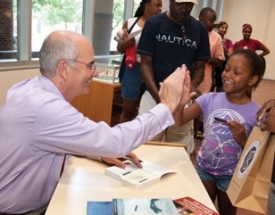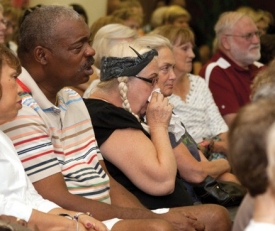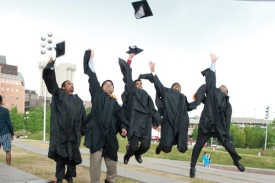Campus News
Novel technology could vastly improve cancer diagnosis
Pediatric researchers have developed a genetically re-engineered herpes virus that selectively hunts down and infects cancerous tumors, then delivers genetic material that prompts cancers to secrete a biomarker to reveal their presence. Currently being tested in the lab, the novel technology could vastly improve cancer diagnosis by allowing the disease to be caught at much earlier stages and to monitor the effectiveness of therapy. Read more.
Biomarker for prostate cancer
Many men could be spared invasive testing to confirm a prostate-cancer diagnosis based on new UC research reported in the British Journal of Cancer. A specific cancer biomarker in the blood (known as GSTP1) shows promise as a screening tool and could increase the specificity of prostate cancer diagnosis by up to 70 percent, compared to the traditional test that cannot differentiate between prostate cancer and benign prostate conditions. Read more.

Nanotechnology
Therapy by ultrafine nanoparticles
Researchers have known for years that RNA — ribonucleic acid, the cousin of DNA — is a promising tool for nanotherapy, in which therapeutic agents can be delivered inside the body via ultrafine “nanoparticles.” But producing long-lasting, therapeutic RNA that remains stable and nontoxic while entering targeted cells has posed difficult challenges.
Recently, UC biomedical engineering faculty have published details on how to successfully produce large RNA nanoparticles that can more effectively deliver therapeutics to diseased tissues. The milestone in RNA nanotherapy was published in the journal Molecular Therapy. Read more.
Telemedicine for veterans with traumatic brain injuries
Local veterans with traumatic brain injuries will soon be able to receive cognitive therapy from trained professionals in their homes with their families, thanks to a newly funded telemedicine program. Developed by experts from the Cincinnati Department of Veterans Affairs Medical Center and UC College of Allied Health Sciences, the program provides veterans with computers equipped with interactive therapy software and videoconferencing capabilities so they can receive cognitive therapy in their home or work environment at their convenience. The goal is to improve veterans’ access to care and help them relearn how to regulate their environment and avoid anxiety while adjusting to a regular home life and employment. Read more.
Preventing kidney-transplantation rejection
UC transplant surgeons completed the first head-to-head comparison of the three most common agents used in the early post-transplant period to prevent rejection following kidney transplantation. Results published in the New England Journal of Medicine provide a strong evidence base for clinicians to weigh advantages and disadvantages of available treatments to obtain higher patient and transplantedorgan survival rates. Read more.
Instant detection of heavy metals in humans
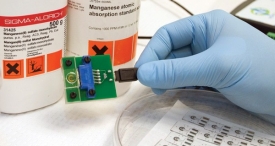
Photo/Dottie Stover
UC engineers and epidemiologists have melded minds to create the first “lab-on-a-chip sensor” for measuring heavy metals in humans. The disposable, yet eco-friendly, device requires just a few drops of blood to measure manganese and provides nearly instantaneous results. The sensor is expected to be ready for initial field-testing in 2012 as part of a UC study looking at air pollution and its effects on childhood health, particularly related to the heavy metal manganese in southeastern Ohio communities. Read more.
New names for RWC, College of Business
In June 2011, the UC Board of Trustees changed the name of Raymond Walters College to UC Blue Ash College and the name of UC’s business school to the Carl H. Lindner College of Business.
The UC Blue Ash name more effectively projects the UC brand and the campus location, board members said. Walters will still be honored on that campus as UC’s longest-tenured president when the Science and Allied Health Building is renamed Walters Hall.
The Carl Lindner name honors the philanthropist’s support of UC and the community, as well as his entrepreneurial spirit. His family founded United Dairy Farmers in 1940, and Carl is founder and chairman of the board of American Financial Group. To further honor Lindner, UC donors have formed the Friends of Carl Lindner to lead fundraising efforts for the college.
New deans at CCM and College of Medicine
The College of Medicine welcomed Thomas Boat in July 2011 as dean and vice president for health affairs. Since 2008, Boat had been the college’s executive associate dean and CEO of UC Physicians.
Previously, he served as director, Children’s Hospital Research Foundation; chairman, UC’s pediatrics department; physician-in-chief, Cincinnati Children’s Hospital Medical Center; pediatrics chairman, University of North Carolina, Chapel Hill; and co-director, Cystic Fibrosis Center, Rainbow Babies and Children’s Hospital, Cleveland.
His research has focused on treating chronic lung diseases in children and mental-health issues in pediatric care.
The College-Conservatory of Music named alumnus Peter Landgren dean in September 2011. Landgren, CCM '78 ('05), had been the conservatory director at Baldwin-Wallace College; served on faculty at the Peabody Conservatory, Johns Hopkins University, for 26 years prior to that; and played horn in the Baltimore Symphony Orchestra for 29 years.
While a CCM student in the mid-’70s, Landgren won the school’s concerto competition three times, was the Cincinnati Ballet Orchestra principal horn and performed and recorded with the Cincinnati Symphony Orchestra. His late mother-inlaw, Elma Gillespie Schonbach, was an alumna, CCM ’37.
resident shares stories from autobiography at library
When UC President Gregory Williams took the stage at the downtown Cincinnati Public Library in July 2011, he joked about having been afraid no one would show up. As he spoke, however, library employees were setting up several more rows of chairs to accommodate the crowd.
Williams talked and read from his book, “Life on the Color Line: The True Story of a White Boy Who Discovered He Was Black.” When he was a child, he told the crowd, libraries were important places where he could read about heroes. “I spent hours in libraries to escape the reality of my own life.”
One unidentified woman (black blouse) was particularly eager to meet the author because she shared a similar story: Although she looked white, her ancestors had been slaves. During the Q&A, she came to the microphone weeping to thank him for his inspirational words.
The president also talked about the progress on his next book, which deals with ancestors who were slaves in Bowling Green, Ky. “My great-grandfather was 10 years old when Lincoln signed the Emancipation Proclamation,” he said. “But writing is slow these days. My day job keeps me kind of busy.”
$1 billion budget
UC’s 2011-12 budget totals just a bit more than $1 billion, which projects a surplus of $17.4 million. To balance the budget, a university-wide budget cut of 12 percent was necessary, and some departments took bigger cuts to build reserves and protect critical units.
At the same time, the UC Foundation announced that fiscal year ’11 contributions to its Proudly Cincinnati campaign totaled $107.8 million, bringing the campaign’s total to more than $788.9 million.
Music thwarts dreams
Da-da-da-dum. Identifying the familiar notes that begin Beethoven’s Symphony No. 5 stumped Peirce Johnston, MD ’07, on a “Who Wants to Be a Millionaire” episode that aired in May 2011.
Johnston successfully fielded eight questions on such diverse topics as movies, explorers and nuts, but the $100,000 question identified the first three notes of Beethoven’s Fifth (all are G-naturals) and asked him to name the fourth note. Having used all his “lifelines,” Johnston chose to end the contest and walk away with the $38,600.
“If I had to pick a question to walk away from, it would be a question like that,” says Johnston, “I’ve never studied music, and I had no guilt about not knowing it.” (The answer is E-flat.) Johnston is a fourth-year resident in UC College of Medicine’s department of psychiatry and behavioral neuroscience.
AD Thomas resigns
UC athletics director since 2005, Mike Thomas announced his resignation in August 2011 to become AD at the University of Illinois. In the last three years, UC’s 18 teams and 560 student-athletes gave the university one NCAA individual champion, four Big East team titles, 12 All-Americans and 72 All Big East honorees. Deputy director Bob Arkeilpane was named interim director.
Capacity crowds at graduation
Approximately 4,800 students were jumping for joy when they graduated in June 2011. Their numbers pushed the total of living alumni to more than 250,000. Capacity crowds filled Fifth Third Arena for two ceremonies on Saturday, June 11; a doctoral hooding and master’s ceremony was held the day before. On Saturday, commencement speaker John Barrett, Bus ’71, told students, “In realizing one dream, be ready for the next, because achieving one goal often creates another opportunity. So stay open to opportunities. Whatever you do, be an active participant, not a witness.”
Banned flowers in innocent hands
In prison, inmates cannot have flowers. Inmate Beverly Monroe knew it, yet she risked everything to snap off wild blooms and press them into a book. Once they were dry, she used toothpaste to affix them to cards she had made, then enclosed them in handmade envelopes to send to friends.
In spring 2011, she was standing at a UC-hosted international conference telling her story to people who understood best — more than 100 innocent people who had been exonerated from jail and more than 400 guests, representing at least 20 countries.
The 2011 Innocence Network Conference met at the National Underground Railroad Freedom Center in downtown Cincinnati to explore wrongful convictions on an international level, a first for the conference. The Ohio Innocence Project, housed at the University of Cincinnati, hosted the event to bring together scholars, lawyers and exonerees from around the world to learn from one another, in the hope that the experience would galvanize a unified international human-rights movement, said Mark Godsey, Ohio Innocence Project director and UC professor.
One highlight of the conference was an exhibit of artistic endeavors by those who had been falsely imprisoned — essays, poetry and visual art. In Monroe’s presentation, she recalled, “When I walked through the prison yard, I would look at the ground to block out the razor-wire fence. I saw little wildflowers. They were contraband, but I hid them in a book — to resist anything that would ban beauty.”
UC student designs new logo
Having introduced new and innovative technologies to make the company a “leader in the digital age,” the J.C. Penney Co. wanted an updated image and logo. Suggestions and submissions were sought from the company’s own art associates, several design agencies and two art schools — the Rhode Island School of Design and the University of Cincinnati.
Out of all those artistic minds, who designed the new Penney’s logo? Third-year UC graphic design student Luke Langhus. Part of a class assignment in adjunct professor Stan Brod’s course, Langhus’ simple design reintroduced a red box from early renditions and retained the same typeface — although in all lowercase letters and with no punctuation. Apparently Langhus’ logo had a more important impact, as the company now refers to itself as “jcpenney.” No uppercase letters. No punctuation.
.




“Our new logo reflects the modern retailer we’ve become while continuing to honor our rich legacy,” says UC grad Myron “Mike” Ullman, Bus ’69, HonDoc ’06, chairman and chief executive officer for the company. The new logo was introduced in February during the Academy Awards.
National Council for Black Studies moves to UC
The National Council for Black Studies moved its headquarters to the UC Department of Africana Studies, headed by department head and council vice president Terry Kershaw. The move will “increase our national prominence and will solidify our place as a national center for Africana studies,” said Valerie Hardcastle, dean of the McMicken College of Arts and Sciences.
UC one of country's best for undergrad education
According to the Princeton Review, the University of Cincinnati is one of the country’s best institutions for undergraduate education. UC was also among the 153 colleges that were recommended in its “Best in the Midwest” feature.
These findings were reported in the 2012 edition of the Princeton Review’s annual guide, “The Best 376 Colleges.” Institutions were chosen for recognition based on meeting “standards for academic excellence within their region” and through student surveys.
UC student surveys praised it as a large university with small-town warmth, with “great programs and infinite opportunities.” Another student noted, “UC has students from all walks of life, which makes it extremely diverse and very interesting.” This marks the fifth year in a row that the university has been included in the guide.
Tea, crafts, music for Japanese relief
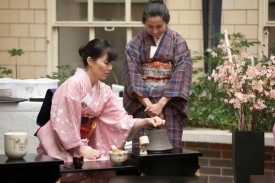
Photo/Lisa Ventre
Two women in traditional dress perform a calming, centuries-old Japanese tea ceremony on campus in April 2011 as part of the kick-off event of the Greater Cincinnati Japan Relief Project. The event aimed to generate donations for the country devastated by an earthquake and tsunami in March. Along with the tea ritual, UC students and other participants sampled handmade baked items and Japanese handicrafts, while listening to performances by the Sakura Ladies Chorus, J-Youth Harmony chorus and Greater Cincinnati Japanese Children’s Chorus.

 Past Issues
Past Issues